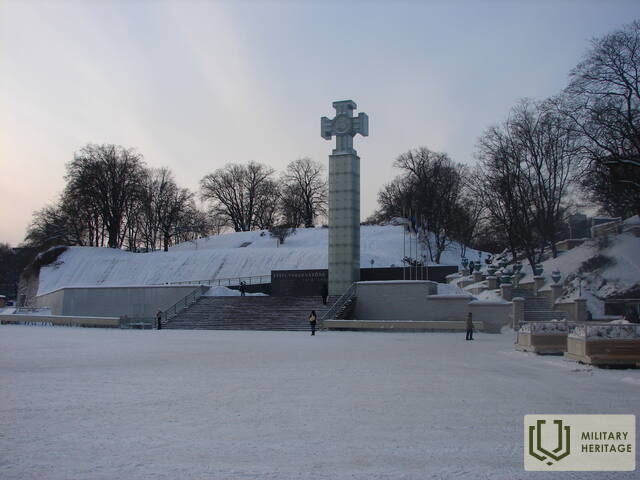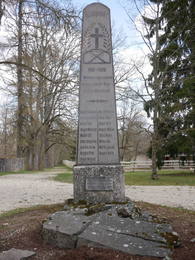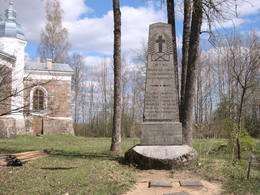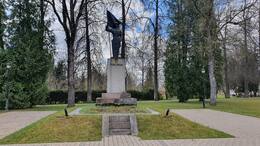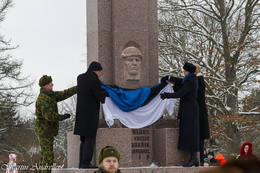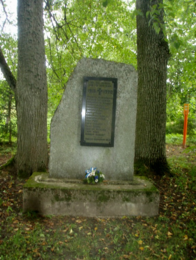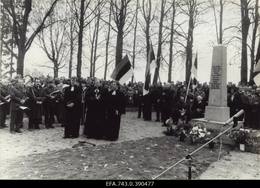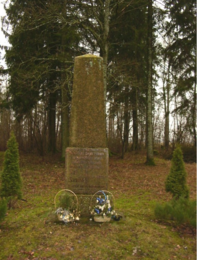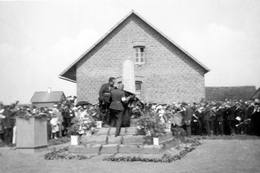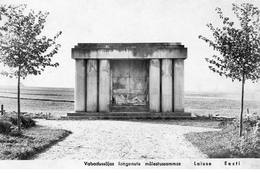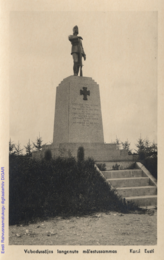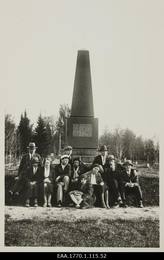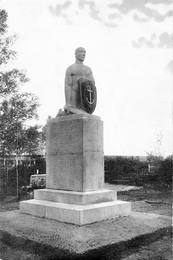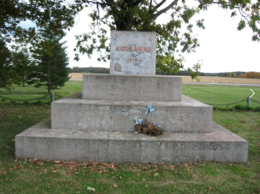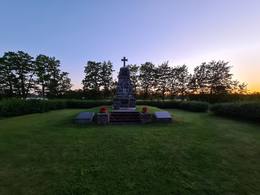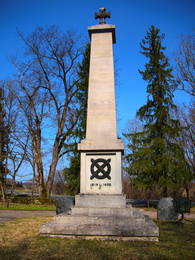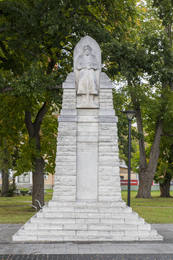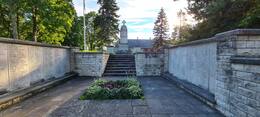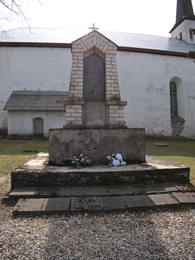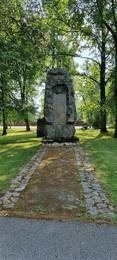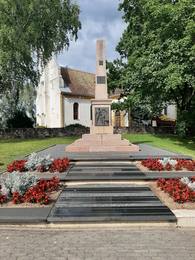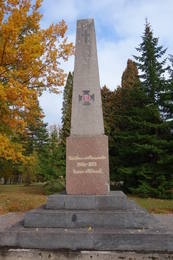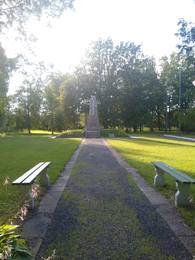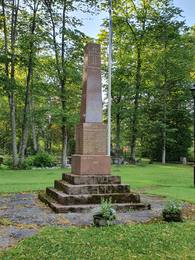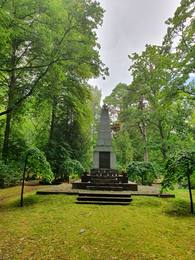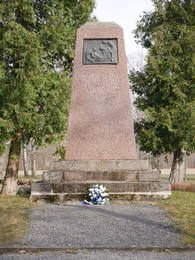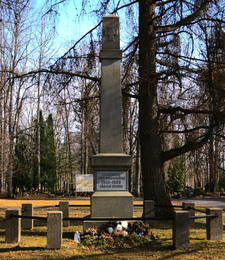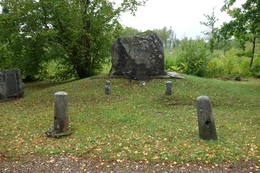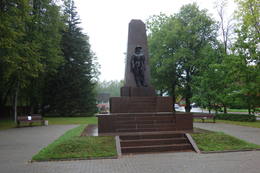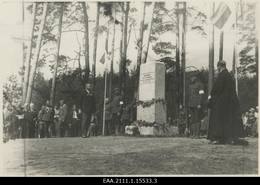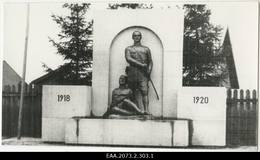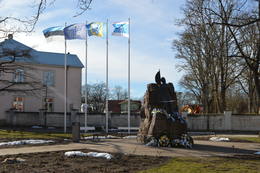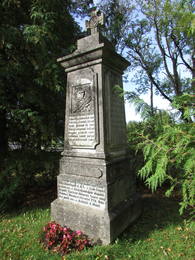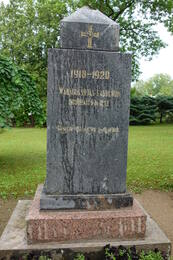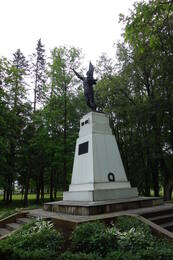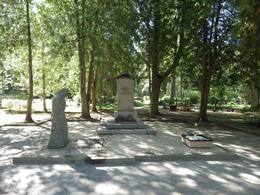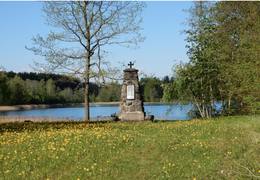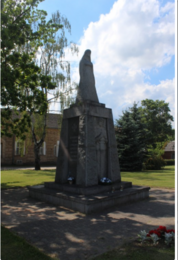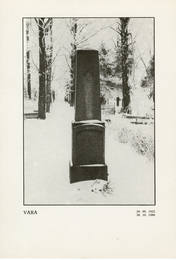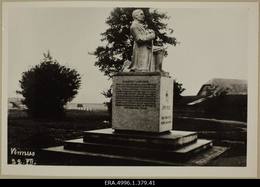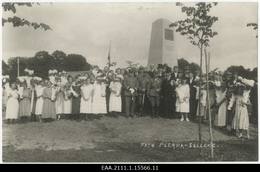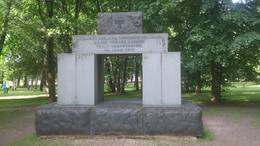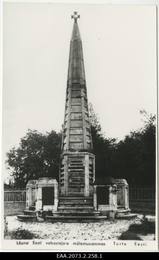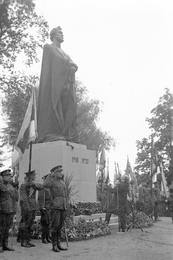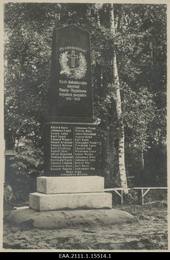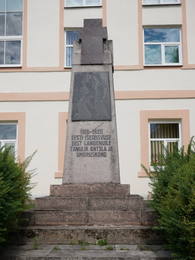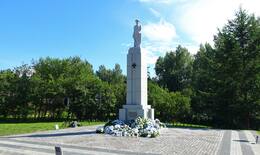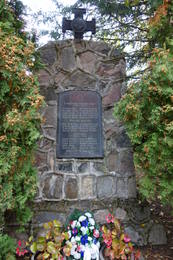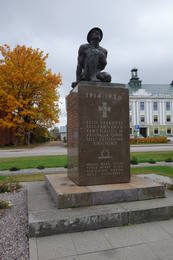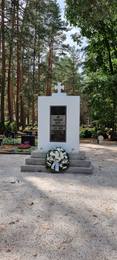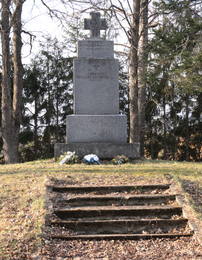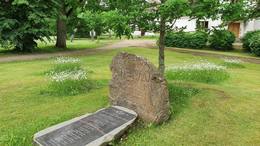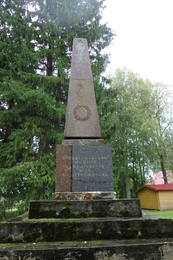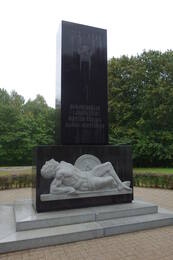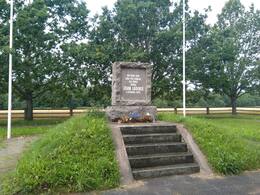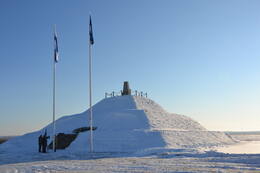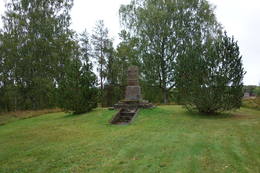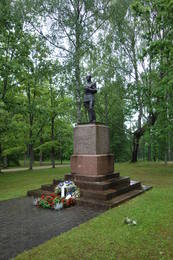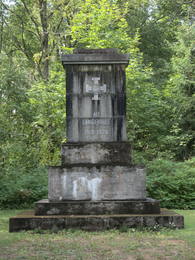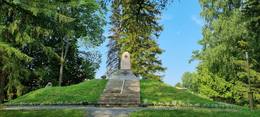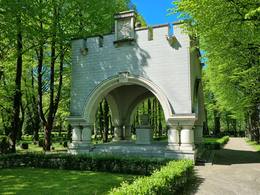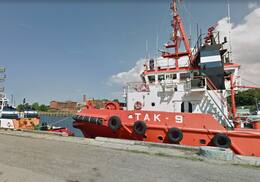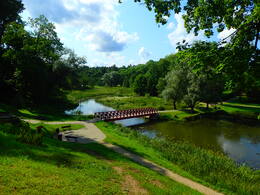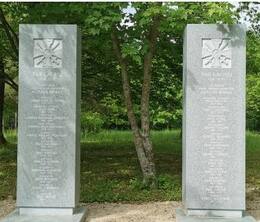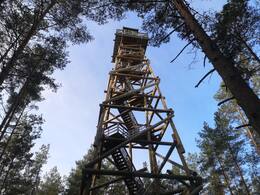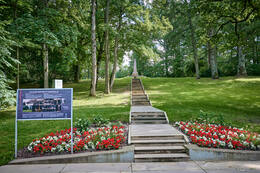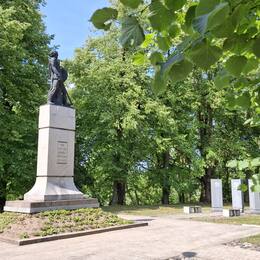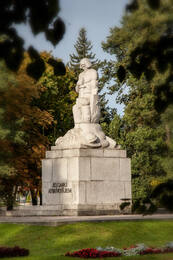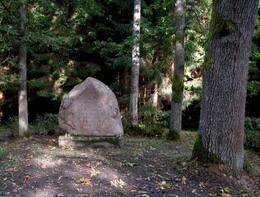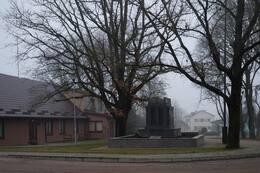Nepriklausomybės karo paminklai
I Nepriklausomybės karai
Visoje Estijoje yra paminklų, skirtų atminti žuvusiems ginant tėvynę Nepriklausomybės kare.
Po Pirmojo pasaulinio karo pasaulio žemėlapyje atsirado daug naujų valstybių. Estijos Respublika buvo viena iš paskutiniųjų, 1918 m. vasario 24 d. paskelbusi nepriklausomybę. Naujagimė respublika turėjo ginti savo suverenitetą Nepriklausomybės kare (1918 m. lapkričio 28 d. – 1920 m. vasario 2 d.), kurio laimėjimas yra vienas didžiausių pasiekimų Estijos istorijoje.
Paminklai paprastai yra gana paprastos formos, tačiau jie tapo Estijos laisvės simboliais. Tarpukariu buvo pastatyta daugiau nei 170 šių paminklų. Dauguma šių paminklų buvo skirti žuvusiems vietos vyrams, daliniams ar Raudonojo teroro aukoms. Kiti žymėjo mūšio vietas arba liniją, kurioje buvo sustabdytas priešo puolimas.
Sovietų okupacijos metu dauguma šių laisvės paminklų buvo sunaikinti, subjauroti arba paslėpti, tačiau jie neišdildė atminties. Kai tik buvo įmanoma, pradėtas masinis paminklų restauravimas; kai kurie buvo atkurti į pirminę būklę, kiti pakeisti ir patobulinti. Dauguma šių paminklų šiandien yra restauruoti. Be to, atidengta 12 naujų Nepriklausomybės kovų paminklų.
Susijusios vietos
Nepriklausomybės karo paminklas Kolga-Jaani miestelyje
Šis paminklas netoli bažnyčios Kolga-Jaani miestelyje buvo atidengtas 1925 m. rugsėjo 19 d. Juo pagerbti 17 kare žuvusių Kolga-Jaani liuteronų, nes Lalsi paminklas buvo skirtas iš tos pačios parapijos žuvusiems stačiatikiams. Šis išskirtinumas būdingas tik Nepriklausomybės karo paminklams. Paminklas buvo nugriautas 1941 m. birželio 19 d. per pirmąją sovietų okupaciją. 1988 m. gegužės 29 d. toje vietoje buvo atidengtas bronzinis Villemo Reimano, dvasininko ir vieno svarbiausių Estijos nacionalinio judėjimo lyderių, biustas. Nepriklausomybės karo paminklas buvo restauruotas ir iš naujo atidengtas po metų, 1989 m. gegužės 28 d., pietinėje bažnyčios šventoriaus dalyje. Tai mažesnė originalaus paminklo kopija. Senojo paminklo dalys yra priešais naująjį.
Nepriklausomybės karo paminklas Tarvastu mieste
Šis paminklas buvo atidengtas 1937 m. birželio 23 d. mažame Mustlos miestelyje. Jis buvo nugriautas 1941 m. birželio 18 d. sovietų okupacijos metu, o iš naujo atidengtas 1942 m. liepos 12 d. vokiečių okupacijos metu. 1948 m. jis vėl buvo nugriautas, o 1990 m. buvo atidengtas restauruotas variantas. Paminklas buvo restauruotas pagal originalą, su tik nedideliais pakeitimais. Centrinė paminklo detalė yra bronzinis kareivis, vienoje rankoje laikantis vėliavą, o kitoje – skydą, kuriame pavaizduoti trys leopardai. Jis stovi ant granito cokolio, kuris savo ruožtu remiasi į dviejų pakopų pagrindą. Verta paminėti kareivio dėvimą šalmą: jis buvo sukurtas pagal garsųjį vokišką Stahlhelm, atspindintį „spalvingą“ tiekimo situaciją Nepriklausomybės karo metu.
Nepriklausomybės karo paminklas Kõpu miestelyje
Šis paminklas, esantis mažame Kõpu miestelyje, buvo atidengtas 1933 m. rugsėjo 17 d. Jį suprojektavo Alfredas Leiusas. Kaip ir kitiems paminklams, buvo naudojamas rudasis granitas. Paminklas buvo nugriautas 1941 m. birželio 17 d. ir panaudotas kaip statybinė medžiaga. Jis buvo iš naujo atidengtas 1989 m. birželio 23 d. Didelė originalaus paminklo dalis buvo pastatyta kelio, vedančio į paminklą, pakraštyje. Ant vienos iš nuo originalo nupūstų dalių vis dar galima įžiūrėti Laisvės kryžiaus atvaizdą.
Kehros mūšio paminklas
1919 m. sausio 4 d. įvykęs Kehros mūšis buvo pirmoji sėkminga šarvuočių puolimo ataka ir lūžio taškas Nepriklausomybės kare, sustabdęs sovietų puolimą Talino link. Pasak legendos, atvykęs į šią vietą generolas Laidoneris asmeniškai pareikalavo pažymėti mūšio lauką. Šis paminklas buvo paskutinis, užbaigtas iki Antrojo pasaulinio karo. Jis niekada nebuvo oficialiai atidengtas – 1940 m. birželio 23 d. turėjusi įvykti atidengimo ceremonija buvo atšaukta dėl sovietų pajėgų invazijos. 6,5 metro aukščio paminklas buvo susprogdintas 1944 m. pabaigoje (nors kai kurie šaltiniai teigia, kad tai įvyko dar 1940 m.), o jo akmeniniai blokai buvo panaudoti netoliese esančių vasarnamių statybai. Geležinkelio stotelė prie paminklo, kuri nepriklausomybės laikais buvo pavadinta Lahinguvälja (Mūšio laukas), 1957 m. sovietų režimo buvo pervadinta į Vikipalu. Atkūrus nepriklausomybę, stotelei buvo suteiktas pirminis pavadinimas. Paminklas buvo restauruotas mažesniu pavidalu, panaudojant išlikusias originalo dalis, ir atidengtas 2000 m. birželio 23 d. Atkurtas originalia forma, jis iš naujo atidengtas 2019 m. sausio 6 d., minint Estijos Respublikos šimtmetį. Koloną puošia kareivio veido reljefas ir užrašas: „Čia buvo sustabdytas priešo puolimas ir taip prasidėjo mūsų pajėgų žygis į pergalę 1919 m. sausio 4 d.“.
Nepriklausomybės karo paminklas Kaareperėje
Šis paminklas yra prie Tartu–Jõgevos kelio, Kaarepere kaime.
Jį sudaro netaisyklingos formos akmuo, stovintis ant betoninio pamato. Ant uolos pritvirtinta tamsiai pilka granito lentelė yra originali; likusi paminklo dalis yra kopija.
Lentelėje užrašyta: „Jūsų kapų nutiestas kelias veda mus į gyvenimą“, o po ja pavaizduotas Laisvės kryžius ir 1918 bei 1920 metai.
Paminklas buvo atidengtas 1933 m. vasario 24 d. ir iš naujo atidengtas 1990 m. vasario 24 d.
Kõnnu mūšio paminklas
Šis paminklas yra prie Jõgevos–Mustvės kelio, netoli Tormos miestelio.
Paminklo restauravimas, kurį užsakė Gynybos lygos Tormos regioninio padalinio vadas Leopoldas Krausas, buvo atliktas 1930 m. liepos 27 d. Paminklas buvo sunaikintas 1948 m. spalio 26 d., o jo dalys užkastas. 1988 m. liepos 14 d. dalys buvo surinktos ir panaudotos paminklo restauravimui, kuris iš naujo buvo atidengtas tų pačių metų spalio 15 d. Kai kurios originalios dalys yra šalia dabartinio paminklo.
Nepriklausomybės karo paminklas Saduküloje
Šis paminklas yra netoli mokyklos Saduküloje, 15 km nuo Jegevos.
Gynybos lygos Härjanurme kuopos užsakytas paminklas žymi tašką, kurį Raudonoji armija buvo pasiekusi iki 1919 m. Jis buvo atidengtas 1930 m. liepos 6 d. Po Antrojo pasaulinio karo paminklas buvo išardytas, o užrašą ant jo pašalino kalvis. Visos dalys išliko, o restauruotas paminklas buvo iš naujo atidengtas 1989 m. birželio 24 d. vietos Gynybos lygos narių pastangomis.
Ant obeliską laikančio smailėjančio postamento užrašyta: „Čia, 1919 m. sausį, Estijos žmonių drąsa pasakė iš rytų plūstančiai raudonajai bangai: Čia ir ne toliau.“
Lohusuu mūšio paminklas
Šis paminklas yra 200 m atstumu nuo Tartu–Jehvi kelio, mažame Lohusuu miestelyje. Jį sudaro obeliskas ant keturių pakopų pagrindo. Obelisko priekyje užrašyta: „Šią krauju pateptą žemę, kurioje mano brolis mirė iki paskutiniųjų savo dienų, aš stengsiuosi ginti! Lohusuu mūšis Nepriklausomybės kare, 1918 m. gruodžio 14 d.“ Obelisko gale pridėtas tekstas: „Atidengtas 1931 m. liepos 26 d. Sunaikintas 1940 m. Iš naujo atidengtas 1990 m. birželio 23 d.“
Paminklas, atidengtas 1931 m. liepos 26 d., buvo skirtas žuvusiems Lohusuu mūšyje Nepriklausomybės kare. Sovietų režimas jį nugriovė, o obeliskas buvo panaudotas kaip Didžiojo Tėvynės karo paminklo Avinurmėje dalis. Paminklas buvo restauruotas kaip kopija ir iš naujo atidengtas 1990 m. birželio 23 d.
Laiusės Nepriklausomybės karo paminklas
Šis paminklas yra Laiusės kapinėse, Vilinos kaime, Jegevos savivaldybėje.
Jis skirtas parapijos gyventojams, žuvusiems Nepriklausomybės kare. Jį suprojektavo Antonas Starkopfas, o atidengta 1925 m. rugpjūčio 30 d. Jis buvo nugriautas 1941 m. liepą, o vokiečių okupacijos metu vėl surinktas. Vėliau, 1954 m., jis buvo nugriautas.
Memoriale buvo pavaizduota graikų stiliaus šventykla. Dviejų pakopų pamatai rėmė šešias gofruotas dorėnines kolonas, laikančias masyvią kūginę plokštę. Viduryje buvo atvira erdvė su lentele, kurioje buvo išvardyti žuvusiųjų vardai, ir sarkofagu su žuvusio kareivio atvaizdu.
1998 m. vasario 22 d. buvusio paminklo, kurį sunaikino sovietų režimas, vietoje buvo pastatytas architekto Ilmaro Kannelmäe suprojektuotas atminimo kryžius. Naujajame dolomito kryžiuje yra Laisvės kryžiaus reljefas ir užrašas „Rm 14, 7-9“, o abiejose kryžiaus papėdėje esančiose lentelėse iškalti žuvusiųjų vardai ir pavardės. Kairėje pusėje esančioje lentelėje užrašyta: „ŽUVĘ NEPRIKLAUSOMYBĖS KARE“, po to – 20 vardų. Dešinėje pusėje išvardyti 24 vardai ir pavardės. Kitoje pusėje yra tekstas: „ŽUVUSIEMS ESTIJOS NEPRIKLAUSOMYBĖS KARE“ ir „PASAULINIO KARO IR SOVIETINĖS OKUPACIJOS AUKOMS“.
Nepriklausomybės karo paminklas Puurmanyje
Šis paminklas yra netoli nedidelio Puurmanio miestelio, prie Puurmanio ir Tabiverės kelio.
Skulptūrą, kurią suprojektavo Voldemaras Mellikas, 1926 m. rugsėjo 26 d. atidengė Kuperjanovo partizanas, gulintis ant granito postamento ant savo šautuvo. Bronzinė statula dingo sovietmečiu. Postamentas buvo susprogdintas, o kalva, ant kurios ji stovėjo, sulyginta 1948 m. Vietoj jos buvo pastatytas Raudonosios armijos paminklas, kuris 1970 m. buvo pakeistas Didžiojo Tėvynės karo paminklu. Kadri Metsik sukurta restauruota originalaus paminklo versija buvo iš naujo atidengta 1992 m. birželio 23 d. Aplink paminklą pasodintas naujas parkas, kurio medžiai pavadinti Nepriklausomybės kare žuvusių ir kitų žymių Kursų parapijos asmenybių vardais.
Šaltiniai:
Nacionalinės paveldo tarybos kultūros paminklų registras. https://register.muinas.ee/public.php?menuID=monument&action=view&id=27111
Nepriklausomybės karo paminklas Palamuse
Šis paminklas yra Palamuse naujosiose kapinėse.
Antono Starkopfo suprojektuotas paminklas buvo atidengtas 1924 m. gegužės 29 d. Granito obeliskas buvo sumontuotas ant trijų pakopų pagrindo, kurio apačioje buvo išgraviruoti 25 Pirmajame pasauliniame kare žuvusių ir 32 Nepriklausomybės kare žuvusių žmonių vardai. Sovietų režimas jį nugriovė 1952 m. Naujasis paminklas, atidengtas 1994 m. gegužės 29 d., yra tiksli originalo, kurį sukūrė Paulas Uibopuu, kopija.
Nepriklausomybės karo paminklas Tormoje
Šis paminklas yra Vanamõisa kaimo kapinėse, netoli Tormos miestelio.
Suomių architekto Ivari Anttila suprojektuotas paminklas buvo atidengtas 1923 m. birželio 17 d. Jame pavaizduotas klūpantis kareivis, panašus į estų liaudies didvyrį Kalevipoegą, dešinėje rankoje laikantis kardą, o kairėje – skydą, pritvirtintas prie rudo granito pamato. Į rytus nukreipta statula 1940 m. buvo pasukta į vakarus, o 1942 m. – atgal. Sovietų režimas ją nugriovė 1948 m. Kai kurios dalys buvo užkastas. Statulos galva dingo ir buvo rasta tik po daugelio metų. Tiksli originalo kopija buvo atidengta 1992 m. birželio 23 d. Originalus kryžiaus raštas buvo pakeistas į Laisvės kryžių. Likusios originalios dalys eksponuojamos Tormos bažnyčios šventoriuje.
Pergalės altorius Aidu mieste
Pergalės altorius yra šalia buvusios pieninės Vaadu ūkyje Aidu miestelyje, prie Jõgevos–Põltsamaa kelio.
Tai Nepriklausomybės karo paminklas. Šis paminklas žymi tolimiausią Raudonosios armijos kareivio žygio tašką.
Eduardo Järve suprojektuotas paminklas buvo atidengtas 1929 m. birželio 23 d. 1932 m. šalia paminklo buvo pasodinti du ąžuolai, vienas iš jų išliko. 1934 m. sausio 4 d. 2-asis pėstininkų batalionas Tartu Lembitu kareivinių aikštėje persodino iš Aidu atvežtą ąžuolą Aidu mūšio garbei.
1934 m. sausio 4 d. 2-asis pėstininkų batalionas Aidu mūšyje išrovė vieną iš ąžuolų ir atsodino jį aikštėje priešais Lembitu kareivines Tartu mieste, Aidu mūšio atminimui. Paminklas buvo susprogdintas 1940 m., o visiškai sunaikintas 1965 m. Dabartinė originalaus paminklo kopija buvo atidengta 1989 m. birželio 23 d.
Vormsio Laisvės kovų paminklas
Šis paminklas yra 2,5 metro aukščio granito riedulys, kurio priekinė pusė yra poliruota. Jis stovi prie vakarinių Hullo bažnyčios šventoriaus vartų, po pušimis. Paminklas buvo atidengtas 1929 m., o data iškalta uoloje. Tai vienas iš nedaugelio Nepriklausomybės karo paminklų, išlikusių po sovietų okupacijos. Galbūt padėjo tai, kad paminklas yra švedų kalba ir jame nėra įrašytų metų 1918–1920. Ant paminklo užrašyta: „Salos gyventojai pastatė šią uolą 1929 m. laisvės kovotojų garbei“. Jis pastatytas ant akmeninio pagrindo. Paminklą aptver akmeniniai stulpai su grandinėmis.
Nepriklausomybės karo paminklas Nõvoje
Pirmasis paminklas Nõvos kaime buvo atidengtas 1928 m. rugsėjo 9 d., siekiant pagerbti Nepriklausomybės kare žuvusius arba dingusius be žinios savivaldybės gyventojus. Tai buvo Vasalemos kalkakmenio kenotafas su frontonu, pritvirtintas prie cokolio ir vainikuotas lotynišku kryžiumi. Paminklą sunaikino sovietų okupacinės pajėgos prieš pat Antrąjį pasaulinį karą. Jis buvo iš naujo atidengtas 1989 m. rugpjūčio 6 d. Restauravimo darbų metu prie memorialo buvo pridėti du kenotafai, kuriuose įvardyti Antrajame pasauliniame kare žuvusiųjų ir komunizmo aukų vardai. Ant originalaus paminklo taip pat buvo įrašyti Pirmajame pasauliniame kare žuvusiųjų vardai.
Metaliniai vainikai, kurie kažkada buvo padėti prie memorialo papėdės, 2018 m. pavasarį buvo rasti kapinių koplyčios palėpėje. Ant vieno iš vainikų iš dalies išsaugota juostelė skelbia: „...kritę kareiviai, kuriuos pagerbė Nõvos tikintieji“.
Tikėtina, kad tai buvo vainikas, kurį 1928 m. rugsėjo 9 d. atidengimui atnešė Nõvos parapija. Kitas vainikas – laurų šakelės su sidabriniais lapais ir vienas vyraujantis žiedas – panašus į pavaizduotą senoje nuotraukoje.
Nepriklausomybės karo paminklas Noarootsi mieste
Šis paminklas, esantis Hosby kaimo kapinėse, susideda iš obelisko ant pjedestalo, abu pagaminti iš lauko akmenų, vainikuoto ketaus Laisvės kryžiumi. Obelisko priekyje pritvirtinta juodo granito lentelė estų ir švedų kalbomis, skirta žuvusiems ar dingusiems iš Noarootsi gyventojų atminimui. Jis buvo atidengtas 1935 m. birželio 10 d., o sovietų okupacijos metu sunaikintas 1948 m. Laisvės kryžius, esantis ant paminklo, vėliau buvo pritvirtintas ant Noarootsi bažnyčios šoninio įėjimo prieangio dešiniosios sienos. Paminklas iš naujo atidengtas 1990 m. birželio 24 d.
Nepriklausomybės kovų paminklas Niguloje
Šis Romano Espenbergo (Haavamägi) suprojektuotas paminklas, esantis Nigulos kaime, Lääne-Nigulos savivaldybėje, buvo atidengtas 1930 m. rugsėjo 14 d. Obeliskas stovi ant laiptuoto pjedestalo, kurio viršuje yra laiptuota piramidė ir vainikuotas bronziniu Laisvės kryžiumi. Pjedestalo priekį puošia bronzinis žemas reljefas, vaizduojantis kareivį, besirūpinantį sužeistu bendražygiu. Paminklas buvo nugriautas 1946 m., tačiau pamatai ir bronzinės detalės išliko. Paminklas iš naujo atidengtas 1989 m. rugsėjo 10 d. Jo dolomito dalys yra tikslios originalo kopijos, o bronzos dalys buvo restauruotos. Paminkle įrašyti 19 Nepriklausomybės kare žuvusių ir 61 Pirmajame pasauliniame kare žuvusių žmonių vardai. Be to, šalia paminklo yra memorialas žuvusiems Antrajame pasauliniame kare ir tremtiniams.
Nepriklausomybės karo paminklas Hapsalu
Šis skulptoriaus Voldemaro Melliko suprojektuotas paminklas buvo atidengtas 1924 m. lapkričio 1 d. Paminklo kaina siekė 746 000 markių – nemaža suma. Paminklas buvo iš dalies finansuojamas aukomis, nes Mellikas kelis kartus atidėliojo jų pastatymo terminą. Tai Lääne apygardos žuvusiems skirtas obeliskas, pagamintas iš dolomito tašų kaimišku stiliumi, ant kurio stovi reljefas, vaizduojantis išsilaikiusį kareivį. Jis buvo nugriautas 1941 m. birželio 19 d., prižiūrint vietos vykdomojo komiteto pirmininkui Evaldui Kaarui. Po nugriovimo jo vietoje buvo įrengta gėlynas su mėlynomis, tamsiai mėlynomis ir baltomis gėlėmis (primenančiomis Estijos vėliavos spalvas), kurios buvo greitai išplėštos. 1942 m. žiemą čia buvo pastatytas iš ledo išdrožtas paminklas. Paminklas iš naujo atidengtas 1994 m. lapkričio 27 d. Visiškai restauruotą paminklą sukūrė skulptorius Vambola Metsas, o statyba vėlgi finansuota geranoriškų Hapsalu gyventojų aukomis.
Nepriklausomybės karo paminklas Kullamaoje
Šis paminklas, pagamintas iš Saremos dolomito, buvo atidengtas 1926 m. liepos 11 d. Jis stovėjo aikštėje netoli bažnyčios Kullamaa, kur dabar stovi memorialas žinomam estų kompozitoriui Rudolfui Tobiasui. Jis buvo sunaikintas 1945 m. ir iš naujo atidengtas 1989 m. rugsėjo 30 d. Dabartinė paminklo vieta yra tarp buvusios klebonijos ir bažnyčios. Paminklą sudaro smailėjantis obeliskas iš išsikišusių ir atgal besileidžiančių blokų ant laiptuoto pagrindo, o viršuje – Laisvės kryžius. Antrasis memorialo etapas buvo pristatytas 1991–1999 m.: devynių pakopų laiptai į platformą, apsuptą grubiai apdailintų kalkakmenio sienų. Jis išsiskiria iš kitų Nepriklausomybės karo memorialų tuo, kad po restauracijos prie memorialo buvo pridėtos lentelės žuvusiems per Raudonąjį terorą ir Antrąjį pasaulinį karą. Laiptai, vedantys į paminklą, yra apsupti sienų, kuriose išvardyti daugiau nei 300 žuvusiųjų vardai.
Nepriklausomybės kovų paminklas Martnoje
Šis paminklas žuvusiems Pirmajame pasauliniame kare ir Nepriklausomybės kovose buvo atidengtas Martnos kaime 1930 m. liepos 6 d. Vėliau, 1953 m. rugpjūčio 27 d., jis buvo sunaikintas (susprogdintas). Jis yra vietinėse kapinėse prie bažnyčios tvoros. Paminklą sudaro smailėjanti plytų statula, primenanti koplyčios duris, pritvirtinta prie betoninio cokolio su dvipakopiu pagrindu. Jo viršuje stovi lotyniškas kryžius. Paminkle iškalti aštuonių Nepriklausomybės kovose žuvusių karių vardai. Be to, yra 14 Pirmajame pasauliniame kare žuvusiųjų vardai. Jo gale iškalta dar 40 vardų. Paminklas iš naujo atidengtas 1992 m. spalio 10 d.
Nepriklausomybės karo paminklas Kanepyje
Šis paminklas stovi šalia Kanepi bažnyčios. Jį suprojektavo ir iškalė vietos skulptorius Aleksandras Jannesas, o atidengtas 1926 m. rugpjūčio 15 d. Jis buvo iškaltas iš plokščio riedulio, rasto bažnyčios pievoje. Paminklo aukštis – 4,27 metro, o virš jo – 76 cm geležinis kryžius. Jį puošia reljefas, vaizduojantis šalmą, durtuvą ir lauro šakelę, o virš jų išgraviruoti metai 1918–1920 (Nepriklausomybės karo trukmė). Užrašas skelbia: „Keleiviau, stovi čia, kad nepamirštum! Mes žuvome kovodami už tai, kad ši estų žemė liktų laisva!“ Paminklas skirtas atminti žuvusiems Pirmajame pasauliniame kare, Nepriklausomybės kare ir Raudonajame terore. Jis buvo restauruotas ir iš naujo atidengtas 1988 m. rugsėjo 25 d.
Nepriklausomybės karo paminklas Põlvoje
Šis paminklas yra šalia Põlvos bažnyčios. Jį suprojektavo skulptorius Aleksandras Elleris. Jis buvo atidengtas 1928 m. liepos 29 d., o trys lentelės prie jo buvo pritvirtintos 1936 m. rugpjūčio 2 d. Paminklas buvo sunaikintas sovietų okupacijos metu 1946 m., bet restauruotas ir vėl atidengtas 1989 m. liepos 29 d. Išliko kai kurie originalūs akmeniniai blokai, ženklas su metais 1918–1920 ir lentelės su žuvusiųjų Pirmajame pasauliniame kare ir Nepriklausomybės kovose sąrašu, kurios buvo panaudotos paminklo restauravimui.
Nepriklausomybės karo paminklas Rapinoje
Šis paminklas yra tarp bažnyčios ir ežero Räpinoje. Jis buvo atidengtas 1927 m. birželio 26 d. Paminklas buvo išardytas 1945 m. rugpjūčio 27 d., o jo dalys užkastas. Dalys buvo rastos 1989 m. vasario 23 d., o paminklas iš naujo atidengtas 1989 m. birželio 24 d., surinktas iš originalių dalių. Obeliskas, pastatytas ant rudo granito cokolio su trimis laipteliais, viršuje turi išgraviruotą lotynišką kryžių, o viduryje – Laisvės kryžiaus atvaizdą.
Pernu Laisvės kovų paminklas
Šį paminklą suprojektavo Amandus Adamson. Jis buvo atidengtas Alevi kapinėse Pernu mieste 1922 m. liepos 16 d. Jo autorius buvo palaidotas šalia 1929 m.
1945 m. balandžio 15 d. paminklas buvo susprogdintas į šipulius, kurie vėliau buvo palaidoti. Berniuko su girlianda statulą už 175 metrų nuo paminklo palaidojo vietos vidurinės mokyklos mergaitės. Laimei, kareivių kapai liko nepaliesti.
Įgulos kapinės buvo atnaujintos 1987 m., o paminklo dalys (įskaitant berniuko su girlianda statulą) buvo atkastos 1988 m. 1989 m. vasario 24 d. buvo atidengta viršutinė paminklo dalis, kuri buvo rasta palaidota originalioje vietoje, su granito lentele su užrašu: „1918 1920 / ČIA BUVO ATIDENGTAS, 1922 M. LIEPOS 16 D. PAMINKLAS / ŽUVUSIEMS NEPRIKLAUSOMYBĖS KARE / SKULPTURIUS AMANDUS ADAMSON / SUNAIKINTAS 1945 M. / 1989 M. II 24 D.“ Paminklo ir kapinių restauravimas buvo atliktas etapais. Paminklas iš naujo atidengtas 1993 m. liepos 17 d.
Nepriklausomybės kovų paminklas Lihuloje
Šį paminklą Lihuloje suprojektavo Richardas Vasardas. Jis buvo pagamintas iš raudono granito, o viduryje – pilko granito kryžius. Po kryžiumi yra užrašas: „Žuvusiems kovoje už laisvę 1918–1920 m.“. Kertinis akmuo buvo padėtas 1935 m. gegužės 19 d., o baigtas paminklas atidengtas 1935 m. rugpjūčio 4 d. Jis buvo susprogdintas 1947 m. rugsėjį. Restauruotas paminklas iš naujo atidengtas 1993 m. birželio 23 d. Pats paminklas neturi lentelių: jos buvo po vieną pridedamos prie šlaitų jo papėdėje. Pirmojoje pridėtoje lentelėje išvardyti 26 Nepriklausomybės kare žuvusių žmonių vardai. Vėliau pridėtos lentelės skirtos Antrojo pasaulinio karo ir Raudonojo teroro aukoms atminti. Šiuo metu lentelėse įvardyti daugiau nei 200 žuvusių žmonių iš aplinkinių savivaldybių vardai.
Nepriklausomybės karo paminklas Mihklyje
Šis paminklas yra Pernu apskrityje, Mihkli kaimo kapinėse. Tai laiptuotas ir smailėjantis obeliskas iš poliruoto tamsiai raudono granito. Obelisko priekinės pusės viršų puošia Laisvės Kryžiaus graviūra. Po ja užrašyta: „Mihkli bendruomenės sūnums, garbingai žuvusiems Didžiajame kare ir Estijos nepriklausomybės kare 1914–1920 m. Mihkli bendruomenė amžinai dėkinga.“ Po juo, visose keturiose obelisko pusėse, iškalti 96 žuvusiųjų vardai. Šie užrašai yra paauksuoti. Paminklo aukštis – 3,05 metro.
Jis buvo atidengtas 1926 m. gegužės 30 d. Skirtingai nuo daugumos Nepriklausomybės karo paminklų, sovietų režimas neturėjo galimybės šio sunaikinti, nes jis buvo paslėptas netoliese esančiose kapinėse, padedant vietos klebonui. Jo restauravimas pasirodė esąs labai paprastas, nes užkastas paminklas buvo puikios būklės ir 1988 m. bendromis vietos gyventojų pastangomis buvo tiesiog grąžintas į pradinę vietą.
Paminklas Nepriklausomybės karui Pernu-Jaagupi mieste
1922 m. Pernu-Jaagupi kapinėse buvo atidengtas paminklas Pernu-Jaagupi parapijos (dabartinės Põhja-Pärnumaa savivaldybės) vyrams, kovojusiems Pirmajame pasauliniame kare ir Nepriklausomybės kare. Paminklas buvo pagamintas Pernu Jüri Walko marmuro ir granito gamykloje. Jis buvo atidengtas 1922 m. rugsėjo 22 d. ir nugriautas 1945 m. Iki 1989 m. gegužės 1 d. paminklo restauravimui buvo surinkta 10 362 rubliai, o paminklas iš naujo atidengtas 1989 m. birželio 18 d. Paminklą sudaro daugiasluoksnis obeliskas ant keturių pakopų pagrindo. Paauksuoti kontūrai obelisko priekyje vaizduoja Laisvės kryžių. Po juo yra tekstas: „Būkite ištikimi iki mirties“. Apatinį obelisko postamentą puošia paauksuotas žuvusiųjų sąrašas pavadinimu „Žuvusiems Jakobi didvyriams“.
Nepriklausomybės kovų paminklas Audru mieste
Šį paminklą, esantį Audru kapinėse, suprojektavo menininkas Erichas Lepsas. Jis buvo atidengtas 1939 m. liepos 2 d. Paminklas buvo nugriautas 1945 m. pavasarį. Paminklo pagrindas liko nepažeistas, o obelisko luitai buvo įmesti į Audru upę.
Paminklas iš naujo atidengtas 1989 m. liepos 2 d. Paminklas pagamintas iš dolomito, o jo galinėje pusėje iškaltos 58 Pirmajame pasauliniame kare žuvusių ir 46 Nepriklausomybės kare žuvusių žmonių vardai.
Nepriklausomybės karo paminklas Tori mieste
Šį paminklą suprojektavo Antonas Starkopfas, o nulipdė akmenkalys Augustas Pärnas. Jis buvo atidengtas Tori kaime, Pernu apskrityje, 1923 m. birželio 24 d.
Paminklas buvo susprogdintas 1945 m. rugpjūtį. Gautos nuolaužos buvo panaudotos kaip betono užpildas Tori tilto statybai. Pažeistą žemąjį reljefą išgelbėjo Nikolajus Kõlvartas, kuris jį paslėpė savo namuose.
1989 m. vasario 23 d. originalioje paminklo vietoje buvo pastatyta balta dolomito lentelė su užrašu: „ŽUVUSIEMS NEPRIKLAUSOMYBĖS KARE 1918–1920 M. NUO DĖKINGOS TORI PARAPIJOS“. Restauruotas paminklas iš naujo atidengtas 1989 m. rugsėjo 30 d. Jame iškalti 73 žuvusiųjų vardai: 21 daugiau nei originale. Paminklas pagamintas iš rausvo granito ir papuoštas bronziniu žemu reljefu bei dekoracijomis.
Nepriklausomybės karo paminklas Vendroje
Šis paminklas buvo atidengtas Vendros miestelyje 1922 m. birželio 24 d. Jį suprojektavo akmenų meistras Oskaras Goldbergas. Paminklas buvo nugriautas 1941 m. Manoma, kad nugriovęs asmuo buvo vietos varpininkas. Vokiečių okupacijos metu jis buvo iš dalies restauruotas: nepažeista viršutinė dalis su Laisvės kryžiaus atvaizdu buvo sumontuota ant plytų pagrindo. 1945 m. paminklas buvo išardytas ir išvežtas į nežinomą vietą. Galiausiai jis buvo rastas devintojo dešimtmečio pabaigoje buvusio valstybinio ūkio vietoje Pärivere. Laikina paminklo versija buvo atidengta 1989 m. birželio 24 d. Kai kurie šaltiniai teigia, kad viršutinė obelisko dalis su Laisvės kryžiaus atvaizdu buvo rasta bažnyčios tvarte 2000 m., todėl restauruotas paminklas buvo galutinai atidengtas 2008 m.
Paminklas Punapargio mūšiui Nepriklausomybės kare
Punapargio mūšis buvo susirėmimas tarp Estijos 6-ojo pėstininkų pulko būrių ir besitraukiančių vokiečių okupacinių pajėgų, įvykęs 1918 m. gruodžio 23 d. netoli Punapargio kaimo Pernu apskrityje. Tai buvo vienintelis rimtas ginkluotas konfliktas tarp estų ir vokiečių pastarųjų traukiantis iš šalies. Pėstininkų pulko žvalgybos būrys mūšyje neteko devynių vyrų; trys buvo sužeisti. Žuvusių didvyrių laidojimas įvyko Pernu gruodžio 26 d. su visomis pagarbomis. Laidotuvių procesijoje dalyvavo daugiau nei 2000 žmonių, įskaitant Gynybos lygos būrį. Vokiečiai neteko 22 vyrų, 30 buvo sužeisti. Žuvę buvo palaidoti Mazsalacos kapinėse. Punapargio mūšio paminklas buvo atidengtas 1934 m. rugpjūčio 12 d. Jis buvo susprogdintas 1950 m. sovietų okupacijos metu. Paminklą sukūrė skulptorius Martinas Saksas. 1988 m. Dainuojančios revoliucijos metu paminklas buvo atstatytas, o restauruota versija atidengta tų pačių metų spalio 15 d. Jame pavaizduotas Laisvės kryžius ir užrašyta: „Drąsa duoda pergalę“.
Nepriklausomybės karo paminklas Kilingi-Nõmme
Šis paminklas Kilingi-Nõmme mieste buvo atidengtas 1933 m. birželio 5 d. Tai kareivio statula, kurią sukūrė skulptorius Antonas Starkopfas, o jos autorius – Kilingi-Nõmme ugniagesių brigados sekretorius ir Nepriklausomybės karo veteranas Lembito Hansbergas.
Paminklas buvo susprogdintas 1945 m. rugpjūčio 13 d. ankstų rytą. Jis iš naujo atidengtas 2008 m. birželio 24 d. Juo pagerbiamas žuvusiųjų tiek Pirmajame pasauliniame kare, tiek Nepriklausomybės kare amžius. Pažymėtina, kad bronzinis kareivis dėvi britiško stiliaus uniformą ir šalmą. Tai rodo platų Nepriklausomybės karo metu naudotų reikmenų asortimentą dėl teikiamos užsienio pagalbos.
Reolos mūšio paminklas
Šis paminklas yra Tõõraste kaime, Kastre savivaldybėje. Jį suprojektavo Antonas Sobolevas, jis skirtas Reolos mūšiui, kuris buvo vienas iš lūžio taškų Nepriklausomybės kare. Šio mūšio, vykusio 1919 m. sausio 16 ir 17 d., metu Estijos pajėgos sužlugdė Raudonosios armijos bandymą užimti Tartu. Paminklas buvo atidengtas 1932 m. liepos 3 d. Po Antrojo pasaulinio karo jis buvo nugriautas ir užkastas. 1988 m. lapkričio 27 d. paminklas, dabar iškastas ir restauruotas Kambjos paveldo asociacijos, buvo atidengtas iš naujo.
Nepriklausomybės karo paminklas Šv. Pauliaus kapinėse
Šis paminklas yra Tartu Šv. Pauliaus kapinių šiauriniame kampe.
Skulptoriaus Aleksandro Ellerio ir miesto architekto Arnoldo Matteuso sukurtas paminklas vaizduoja du Amanduso Adamsono sukurtus kareivius ir buvo atidengtas 1934 m. lapkričio 11 d. Sovietų okupacijos metu skulptūros ir datos buvo pašalintos iš paminklo. 2015 m. spalio 10 d. toje pačioje vietoje buvo atidengtas Nepriklausomybės karo memorialas, kurį sudaro Mati Karmino skulptūra „Kalevas ir Linda“ bei Mati Karmino ir Tiito Trummalo suprojektuota iškilmių aikštė su takais, parko suoliukais ir kryptinėmis šviesomis. Paminklas žymi masinę 254 Nepriklausomybės karo metu žuvusių karių kapavietę.
Nepriklausomybės kovų paminklas Mustjaloje
Šis paminklas yra Sillos kapinėse Mustjaloje, 700 metrų nuo Sillos-Küdemos kelio. Jo aukštis, įskaitant pamatus, yra 160 cm, plotis – 90 cm, o gylis – 20 cm.
Restauruotą paminklą suprojektavo Mati Karmin, o lipdė akmenkalys Volli Sai. Jis buvo atidengtas 2011 m. birželio 26 d. Paminklas skirtas 10 drąsių Mustjalos didvyrių, žuvusių Nepriklausomybės kare. Ant paminklo užrašyta:
„Nėra didesnės meilės, kaip tas, kuris gyvybę už draugus atiduoda.“ Jn 15, 13
DĖKINGI MUSTJALOS SAVIVALDYBĖS ŽMONĖS
ATMINTI NEPRIKLAUSOMYBĖS KARO DIDVYRIUS"
Nepriklausomybės karo paminklas Kihelkonoje
Šis paminklas yra Kihelkonnos kapinėse. Jo mūrą sukūrė skulptorius Mihkelis Munkas. Jis buvo atidengtas 1934 m. rugsėjo 29 d. Paminklas buvo visiškai sunaikintas Antrojo pasaulinio karo metu. Oficialiai jis buvo iš naujo atidengtas 1989 m. birželio 10 d. Dabartinis paminklas yra tiksli originalo kopija. Jis sudaro obeliską, pastatytą ant trijų pakopų pamato. Obelisko priekinę pusę puošia Laisvės kryžiaus atvaizdas, po kuriuo užrašyta: „1918–1920 / NEPRIKLAUSOMYBĖS KARO AUKOMS / DĖKINGI KIHELKONNOS ŽMONĖS“. Cokolį puošia žemas kardo ir vainiko reljefas. Paminklo aukštis – 3,75 metro. Obelisko galinėje pusėje iškalti 15 žuvusiųjų vardai.
Nepriklausomybės karo paminklas Kuresarėje
Šis paminklas yra Kuresarės centre, Lossi ir Lasteaia gatvių sankryžoje.
Jis atidengtas Nepriklausomybės kare (1918–1920 m.) žuvusiųjų atminimui. Paminklo autorius buvo vienas garsiausių Estijos skulptorių Amandus Adamson, kurio žinomiausias darbas yra Russalkos memorialas Taline. Statybos pradėtos Italijoje 1927 m. Paminklas atidengtas 1928 m. Vėliau jį papuošė dvi bronzinės lentelės su išgraviruotais žuvusių ir sužeistų Saremos karių vardais. Paminklas per savo gyvavimo laikotarpį buvo du kartus nugriautas. Bronzinę skulptūrą restauravo skulptorius Matti Varikas, remdamasis senomis originalo nuotraukomis.
Ant paminklo priekinės pusės užrašyta: „Žuvusiems Nepriklausomybės kare 1918–1920 m. nuo dėkingų Saremos žmonių.“
Nepriklausomybės kovų paminklas Valjaloje
Šis paminklas yra Valjalos bažnyčios šventoriuje. Jį sukūrė Antonas Õunapuu. Paminklas, skirtas atminti Nepriklausomybės kare žuvusius Valjalos parapijos karius, buvo atidengtas 1923 m. birželio 24 d. 1944 m. rudenį (kiti šaltiniai nurodo 1947 m. rugsėjį) jis buvo susprogdintas. Naujojo paminklo architektas buvo A. Mändas. Paminklas iš naujo atidengtas 1993 m. birželio 23 d.
Pradinis projektas buvo šiek tiek pakeistas. Dolomito paminklas yra ant laiptuoto cokolio sumontuotas obeliskas su karnizo viršumi. Ant jo stovi dolomito Laisvės kryžius.
Nepriklausomybės kovų paminklas Priimetsos kapinėse
Šis paminklas šiose Valgos kapinėse buvo atidengtas 1925 m. spalio 11 d. Jis yra vienoje didžiausių Nepriklausomybės karo žuvusiųjų laidojimo vietų ir yra paskutinė daugiau nei 300 vyrų poilsio vieta. Deja, ne visi palaidotieji buvo identifikuoti, todėl paminkle įrašyti tik 154 vardai. Vis dėlto paminkle minimi 152, kurių tapatybės nebuvo nustatytos. Paminklas buvo nuverstas 1940 m. rugsėjį, bet 1941 m. liepą vėl pastatytas. Po Antrojo pasaulinio karo paminklas vėl buvo nuverstas ir užkastas.
Jis buvo iš naujo atidengtas toje pačioje vietoje 1988 m. lapkričio 27 d., restauruotas iš originalių dalių. Paminklas yra kuklaus dizaino. Jį sudaro laiptuotas pagrindas, kurio viršuje yra obeliskas. Naudota medžiaga – pilkas granitas.
Nepriklausomybės karo paminklas Valgoje
Šis paminklas, skirtas atminti Pietų Estijos laisvės kovotojus, vaizduoja nežinomo kareivio statulą, vienoje rankoje laikantis vėliavą, o kitą – ištiesęs. Jis stovi ant aukšto pjedestalo. Originalus paminklas buvo atidengtas 1925 m. spalio 11 d., minint leitenanto Juliaus Kuperjanovo 31-ąjį gimtadienį, tačiau 1940 m. rugsėjo 21 d. naktį jį nugriovė sovietų režimas. Jis buvo iš naujo atidengtas originalioje vietoje Kuperjanovi gatvėje Valgoje 2013 m. rugpjūčio 16 d. Originalų paminklą 1925 m. suprojektavo Amandus Adamsonas, kuris taip pat prižiūrėjo bronzinės skulptūros liejimą Italijoje. Skulptorius Jaakas Soansas ją restauravo iki pilno dydžio. Restauravimą organizavo ne pelno siekianti organizacija VIKP (Nuolatinė Valgos patriotinio auklėjimo paroda), Valgos miesto ir apskrities valdžia bei Estijos karo muziejus.
Nepriklausomybės karo paminklas Rannu mieste
Šis paminklas yra Rannu kapinėse. Jį suprojektavo Voldemaras Mellikas, o 1931 m. rugpjūčio 23 d. atidengtas. 1949 m. sovietų režimas jį susprogdino. 1976 m. Kalevas Raave organizavo skulptūros „Rannu motina“ pastatymą buvusio paminklo vietoje. 1991 m. ant Rannu bažnyčios sienos buvo pakabinta atminimo lenta Nepriklausomybės kare žuvusiems šio regiono vyrams atminti. Tuo pačiu metu, kai 2014 m. buvo pradėtas paminklo restauravimas, paminklo dalys atsitiktinai buvo rastos kapinių renovacijos darbų metu. Deja, bronzinis ginklas, šalmas ir kareivio figūra ant paminklo vis dar dingę. „Rannu motinos“ statula buvo perkelta, o restauruotas paminklas iš naujo atidengtas pradinėje vietoje 2015 m. rugpjūčio 23 d.
Nepriklausomybės karo paminklas Pangodyje
Šis paminklas yra Pangodžio ežero pakrantėje, Valstybinio miškų valdymo centro rekreacinėje zonoje, to paties pavadinimo kaime.
Paminklą, kurį suprojektavo Voldemaras Rätsepas, 1934 m. birželio 23 d. atidengtas obelisko formos paminklas buvo pastatytas iš lauko akmenų su kryžiumi viršuje. Paminklo lentelės buvo pašalintos 1940 m., o pats paminklas išardytas 1949 ir 1950 m. Restauruota kopija iš naujo atidengta 1990 m. birželio 23 d., o ant jos pritvirtintos originalios granito lentelės. Paminklo priekyje esančioje lentelėje užrašyta: „Tiems, kurie žuvo vardan laisvės 1918–1920 m.“, po to aštuoni vardai ir „Kodijervės savivaldybė“. Galinėje pusėje esančioje lentelėje užrašyta: „Kilnus siekis amžinai švies per laiko atoslūgius“, o ją puošia ąžuolo vainikas ir sukryžiuoti kardai. 1996 m. originalus kryžius buvo rastas Pangodžio ežere.
Tabletės yra originalios.
Nepriklausomybės kovų paminklas Ringoje
Šis paminklas stovi priešais istorinę Kõveros smuklę (pastatyta maždaug tarp 1807 ir 1830 m.) mažame Rõngu miestelyje.
Skulptoriaus Aleksandro Ellerio sukurtas paminklas buvo atidengtas 1934 m. rugsėjo 30 d. Ant granito pagrindo pritvirtinta bronzinė skulptūra vaizduoja estų epinį didvyrį Kalevipoegą, ginantį savo motiną Lindą, simbolizuojančią estų tautą, su kardu. Skulptūra buvo sunaikinta 1940 m. spalį, bet vėliau restauruota vokiečių okupacijos metu ir vėl atidengta 1941 m. spalio 12 d. Paminklas buvo visiškai nugriautas 1948 m. Dabartinis paminklas, kurį šiek tiek pakeitė Villu Jaanisoo, buvo atidengtas 1995 m. gegužės 21 d. Jis skiriasi nuo originalo tuo, kad viršuje yra Lindos statula, o priešais – ant kardo besiremiančio Kalevipoego statula.
Nepriklausomybės karo paminklas Kambjoje
Šis paminklas yra Kambjos miestelio kapinėse.
Šnekamojoje kalboje „Kambjos Džeku“ vadinamas paminklas buvo suprojektuotas skulptoriaus Aleksandro Ellerio ir atidengtas 1929 m. spalio 27 d. Paminklo pagrindas buvo sudėtas iš akmenų, surinktų žuvusiųjų šeimų ir vietinių gyventojų dirbamose žemėse ir ganyklose Kambjoje. Pasakojama, kad kareivio statula buvo sukurta pagal Villemi ūkio seniūno, parlamento nario Jüri Otto, atvaizdą. Statula buvo nuversta 1940 m. Kardą paslėpė vietos moksleiviai kalvos šlaite, bet jis dingo. Statula buvo atstatyta 1942 m. liepos 12 d., tačiau paminklas buvo visiškai nugriautas 1948 m. gegužės 16 d. Atkurtas paminklas su nauja Aivaro Enneto bronzine skulptūra buvo iš naujo atidengtas 1989 m. liepos 23 d. Garsiausias iš paminkle išvardytų kareivių yra leitenantas Julius Kuperjanovas.
Nepriklausomybės karo paminklas Äksi mieste
Šis paminklas yra prie Tartu–Jõgevos kelio, Voldi kaime, Tartu savivaldybėje.
Skulptūros autorius Voldemaras Mellikas atidengtas 1925 m. birželio 28 d. Ketaus skulptūra vaizdavo sargyboje stovintį estų kareivį, vilkintį žieminiais drabužiais, simbolizuojantį Äksi išlaisvinimą, įvykusį tuo metų laiku. Statula buvo nugriauta 1945 m., tačiau postamentas išliko. Skulptorės Airike Taniloo-Bogatkin restauruotas paminklas iš naujo atidengtas 1989 m. rugpjūčio 27 d. Dabartinė bronzinė skulptūra yra tiksli originalo kopija, tačiau postamentas skiriasi tuo, kad jame vietoj atskiro kalavijo nugarinėje pusėje iškaltas iškaltas kalavijas. Skulptūrą supa ąžuolų giraitė, vadinama Laisvės ąžuolų mišku, kuris buvo pasodintas 1925 m.
Nepriklausomybės karo paminklas Kuusiku miestelyje
Šis paminklas yra Varos kaimo kapinėse. Pastatytas penkių Varos gyventojų, žuvusių Nepriklausomybės kare, atminimui, jis buvo atidengtas 1925 m. rugsėjo 20 d. Jis buvo nugriautas 1950 m., tačiau jo dalys buvo sėkmingai paslėptos. Paminklas, restauruotas naudojant originalias dalis, iš naujo atidengtas 1988 m. spalio 30 d. Jį sudaro trijų dalių obeliskas ant pjedestalo. Paminklo priekinėje pusėje pavaizduotas Laisvės kryžius, po kuriuo įspaustomis raidėmis užrašyta: „Žuvę Nepriklausomybės kare 1919–1920 m.“, po kurio eina penkių žuvusių karių vardai. Galinėje pusėje pavaizduotas lotyniškas kryžius ir užrašas: „Nėra didesnės meilės, kaip gyvybę už draugus atiduoti“.
Nepriklausomybės karo paminklas Võnnu mieste
Šis paminklas yra šalia bažnyčios nedideliame Võnnu miestelyje.
Skirtas žuvusiems Pirmajame pasauliniame kare ir Nepriklausomybės kovose bei Raudonojo teroro aukoms, jį suprojektavo Aleksandras Elleris. Paminklas vaizduoja klūpantį kareivį ant granito pjedestalo. Jis buvo atidengtas 1934 m. liepos 22 d. 1945 m. jis buvo susprogdintas, pjedestalo užkastas, o kareivio statula įmesta į tvenkinį. Paminklas buvo restauruotas iš originalių dalių ir iš naujo atidengtas 1990 m. rugsėjo 1 d. originalioje vietoje. 4,6 metro aukščio paminklą sudaro pilkšvai rudas granito pjedestalas ant trijų pakopų pagrindo, ant kurio stovi klūpančio kareivio su kardu ir skrybėle rankose skulptūra.
Nepriklausomybės karo paminklas Puhjoje
Šis paminklas yra Puhjos parke, netoli Tartu–Viljandi kelio. Jį suprojektavo Antonas Starkopfas, o 1925 m. liepos 5 d. jis buvo atidengtas širdies formos parke, kurį 1920–1921 m. įkūrė vietos ūkininkai Nepriklausomybės kare žuvusiems atminti. Nepaisant įsakymų iš viršaus, paminklas 1950 m. nebuvo susprogdintas, o tik užkastas. 1988 m., Andruso Seppo nurodymu, paminklas buvo iškastas ir grąžintas į pradinę vietą. Teko iš naujo nulieti tik ketaus kalavijus ant obelisko postamento. Jis iš naujo atidengtas 1988 m. rugpjūčio 20 d.
Tähtverės mūšio paminklas
Šis Aleksandro Ellerio suprojektuotas paminklas, skirtas Estijos pergalei prieš Raudonosios armijos latvių šaulius Tähtverės mūšyje 1919 m. sausio 14 d. atminti, buvo atidengtas 1932 m. liepos 3 d. Jis buvo nugriautas 1940 m., bet atstatytas 1942 m. Po karo sovietų režimas paminklą visiškai sunaikino ir galiausiai, 1957 m., pakeitė darbininkų ir profesinių sąjungų judėjimo veikėjo Hanso Heidemanno biustu. Paminklo restauravimą pasiūlė Ennas Tarto, o jis iš naujo atidengtas pradinėje vietoje 2006 m. liepos 2 d.
Pietų Estijos išvaduotojų paminklas ir Raadi karinės kapinės
Šis paminklas yra Tartu Raadi kapinių Nurme gatvės pusėje.
Paminklą, esantį Tartu garnizono kapinėse, pasiūlė dukart Laisvės Kryžiaus kavalierius pulkininkas Siegfriedas Pindingas. Kiekviena paminklo pusė simbolizavo vieną iš pietinių Estijos apskričių, o penki mažesni stulpai – Tartu, Valgos, Viljandžio, Veru ir Petserio miestus. Paminklą sukūrė Antonas Sobolevas ir Voldemaras Mellikas, tačiau dėl lėšų trūkumo jis liko nebaigtas ir buvo atidengtas 1926 m. spalio 17 d. Po Antrojo pasaulinio karo paminklas buvo sunaikintas, o jo dalys užkastas. Originalios dalys buvo iškasta 1988 m. ir panaudotos paminklo restauravimui. Paminklas buvo iš naujo atidengtas 1991 m. liepos 10 d. netoli originalios vietos – vis dar nebaigtos statyti.
Nepriklausomybės karo paminklas Tartu mieste
Šis paminklas yra dešiniajame Emajegio upės krante, prie Vabaduse prospekto (tarp Vabaduse ir Kaarsilla tiltų), Tartu mieste.
Amanduso Adamsono suprojektuotas paminklas buvo atidengtas 1933 m. rugsėjo 17 d. ir jame buvo bronzinė estų epo didvyrio Kalevipoego, besiremiančio į savo kardą, skulptūra. Paminklas buvo pašalintas 1950 m., tačiau žmonėms ir toliau nešant į šią vietą gėlių ir žvakių, 1952 m. buvo atidengtas rašytojo Friedricho Reinholdo Kreutzwaldo biustas. Restauruotas paminklas, kurį pagal senas nuotraukas sukūrė skulptorius Ekke Väli, buvo atidengtas 2003 m. birželio 22 d.
Nepriklausomybės karo paminklas Marja-Magdalenoje
Šis paminklas yra Marijos-Magdalenos kapinėse.
Juodo granito obeliskas, išgraviruotas paauksuotais tekstais, buvo atidengtas 1922 m. rugpjūčio 20 d. 1945 m. paminklas buvo nugriautas ir užkastas. Obeliskas buvo iškastas 1988 m. birželio 22 d. ir vėl atidengtas tų pačių metų liepos 31 d. 2020 m. birželio 23 d., po renovacijos, paminklas buvo atidengtas trečią kartą. Obelisko priekinę pusę puošia sukryžiuotos ąžuolo šakos ir dviejų kardų bei šautuvo atvaizdai. Jame parašyta: „Garbė žuvusiems! Marijos-Magdalenos parapijos sūnums, žuvusiems Estijos Nepriklausomybės kare 1918–1925 m.“ Ant postamento iškalti 31 vardas.
Nepriklausomybės karo paminklas Antsloje
Nepriklausomybės karo paminklas yra priešais rotušę. Šis paminklas skirtas Antslos rajono ir Vana-Antslos, Uue-Antslos, Urvastės ir Vaabinos parapijų vyrams, žuvusiems Nepriklausomybės kare. Jį suprojektavo garsus estų skulptorius Juhanas Raudseppas. Paminklas atidengtas 1925 m. rugsėjo 27 d. Jis buvo nugriautas 1945 m. rugpjūtį. Didžiausi kūriniai buvo užkasti, o mažesni – įmesti į šulinį. Jis iš naujo atidengtas 1993 m. birželio 22 d. Restauruotas paminklas yra beveik tiksli originalo, kurį sunaikino sovietų pajėgos, kopija. Originali ant paminklo pritvirtinta lentelė buvo nulieta iš bronzos, tačiau naujoji versija pagaminta iš juodo granito. Joje pavaizduoti artimieji, atnešantys gėles prie žuvusiųjų kapo. Žuvusiųjų iš Antslos vardas išvardintas paminklo galinėje pusėje.
Paminklas Munamäe mūšiui Nepriklausomybės kare
Šis paminklas, skirtas 1-ojo kavalerijos pulko vyrams, kovojusiems ir žuvusiems Munamegės mūšyje Nepriklausomybės karo metu, buvo atidengtas 1932 m. 1941 m. birželio 14 d. paminklas atskirais gabalais buvo užkastas smėlyje. Neaišku, ar tai buvo padaryta jį griaunant, ar siekiant išvengti jo nugriovimo. Vokiečių okupacijos metu jis buvo restauruotas sujungiant dalis, bet vėl nugriautas 1944 m. Paminklas iš naujo atidengtas 1988 m. rugpjūčio 7 d. Akmenimis grįstas postamentas laiko obeliską primenantį akmeninį bloką. Paminklo priekinėje pusėje pavaizduotas Laisvės kryžius, po kuriuo užrašyta: „Čia kovojo 1-asis kavalerijos pulkas Nepriklausomybės karo metu 1919 m. kovo 20 d.“.
Pečiorių Laisvės kovų paminklas
Šis paminklas Verskoje buvo pastatytas pagal skulptoriaus Romano Haavamäe 1938 m. projektą ir nuotraukas ir yra unikalus tarp restauruotų Nepriklausomybės karo paminklų Estijoje. Iš pradžių paminklas turėjo būti atidengtas Laisvės parke Petserio mieste, tačiau sovietų okupacija tam du kartus sutrukdė – 1940 ir 1944 m. Jis buvo baigtas po 80 metų ir atidengtas naujoje vietoje Verskoje, naujajame Setomos regiono administraciniame centre. Ant jo puikuojasi Petserio miesto herbas, nes paminklą iš pradžių finansavo miestiečiai. Jis skirtas daugeliui žuvusiųjų – kai kuriais skaičiavimais, Petserio apskrityje vykusiuose mūšiuose žuvo apie 350 žmonių. Paminklas yra penkių metrų aukščio ir jį vainikuoja vyro, laikančio kardą, statula ir skydas su trimis leopardais.
Oravos mūšio paminklas
Šį paminklą suprojektavo menininkas Arkadio Laigo, o lipdė statybų meistras S. Põvvatas. Jis buvo atidengtas Oravos kaime, dabartinėje Võru savivaldybėje, 1934 m. liepos 15 d.
Iš pradžių, 1941 m., buvo sunaikinta ant paminklo esanti lentelė. Viso paminklo toks pat likimas ištiko 1945 m. rugpjūčio 31 d. Lentelė ir akmenys buvo užkasti paties paminklo vietoje.
Lentelė ir dauguma akmenų buvo rasti 1989 m. kovo 18 d. Restauruotas paminklas iš naujo atidengtas tų pačių metų liepos 15 d. Be Nepriklausomybės karo žuvusiųjų, paminklas taip pat skirtas Pirmajame pasauliniame kare žuvusiems ir Raudonojo teroro aukoms Nepriklausomybės karo metu atminti. Paminklą sudaro apvali „piramidė“, pagaminta iš lauko akmenų, kurią vainikuoja didelis ketaus Laisvės kryžius. Palyginti su ankstesne vieta, paminklą teko perkelti maždaug 15 metrų ir dabar jis stovi šalia buvusios Oravos rotušės, apsuptas kedrų.
Nepriklausomybės karo paminklas Vastselínoje
Šis granito paminklas, esantis nedideliame Vastselinos miestelyje, Veru apskrityje, – tai klūpančio sužeisto kareivio statula. Ji buvo atidengta 1931 m. ir sunaikinta tik po Antrojo pasaulinio karo 1948 m., kareiviams numetus bronzinę statulą į krūmus. Tai matė vietos gyventoja Anna Avara, o vietos ūkininkai Augustas Soe ir Rudolfas Palu vėliau statulą paslėpė. Ji buvo iškasta 1988 m. ir grąžinta į pradinę vietą. Pažymėtina, kad kareivis dėvi šalmą, pagamintą pagal tuo metu dėvėtų belgų arba britų šalmų modelį. Tai rodo platų Nepriklausomybės karo metu naudotų priemonių spektrą.
Nepriklausomybės karo paminklas Veru mieste
Veru Nepriklausomybės karo paminklas yra Veru miesto kapinėse. Veru kapinėse yra 42 kapai, priklausantys Nepriklausomybės kare žuvusiems kariams. Žinomos 36 čia palaidotųjų pavardės. Jiems skirta teritorija 1928 m. iš senųjų kapinių pusės buvo aptverta grandininiais stulpais, o centre pastatytas paminklas. Paminklas buvo atidengtas 1938 m. birželio 23 d. Jis buvo pastatytas ant trijų pakopų pamato, viršutinė paminklo dalis sudarė du laiptus, kurių viršuje buvo Laisvės kryžius. Paminklas buvo nugriautas 1946 m. ir iš naujo atidengtas 1988 m. birželio 23 d. Tai buvo antrasis Nepriklausomybės karo paminklas Estijoje, viešai atidengtas oficialioje ceremonijoje. Atkurtas paminklas buvo pagamintas iš betono ir yra daug platesnis nei originalus. Ne visi Veru gyventojai buvo patenkinti, kad paminklas buvo restauruojamas: mėnesį prieš jo atidengimą kapinės buvo nuniokotos vandalais, apgadinti antkapiai ir sugadinti žuvusiųjų kapai.
Nepriklausomybės kovų paminklas Pilistverėje
Šis paminklas yra netoli Pilistverės bažnyčios ir skirtas 58 parapijos vyrams, žuvusiems Nepriklausomybės kare. Jį sukūrė skulptorius Aleksandras Elleris. Paminklas buvo atidengtas 1931 m. liepos 26 d. 1940 m. rugpjūčio 19 d. paminklas buvo nugriautas sovietų valdžios įsakymu, bet vėl atidengtas 1942 m. liepos 12 d. Originaliame paminkle buvo bronzinė kareivio statula. Prieš pat vokiečių pajėgų atvykimą 1941 m., paminklas buvo išardytas ir išvežtas į Viljandį. Jo bronzinė statula dėl nežinomų priežasčių dingo, o vokiečių okupacijos metu paminklą teko atkurti be jos. Antrą kartą jis buvo nugriautas 1945 m. rudenį. Trečią kartą paminklas buvo atidengtas 1991 m. liepos 28 d. Kadangi bronzinė statula iki šiol neatrasta, ji buvo pakeista granitiniu Laisvės kryžiumi. Originaliose atminimo lentelėse išgraviruoti 54 žuvusių vyrų vardai.
Nepriklausomybės karo paminklas Kerstnoje
Paminklas, skirtas Kerstnos mūšiui ir jame žuvusiems 18 kareivių atminti, buvo atidengtas 1928 m. rugpjūčio 28 d. Manoma, kad paminklą sukūrė tuometinis Valstybinės meno ir amatų mokyklos Skulptūros katedros vedėjas Leonhardas Pruulas. Kiekvieną paminklo pusę puošia žemas reljefas, kuriame pavaizduota Nepriklausomybės karo mūšio scena. Paminklo priekyje užrašyta: „Šiandien ir ne toliau! Didvyriams, kovojusiems Kerstnos mūšiuose už Estijos laisvę. Didžioji Kerstna“. Kaip ir daugelis Nepriklausomybės karo paminklų, šis taip pat buvo nugriautas 1941 m. Postamentas, išlikęs po pirmojo sprogdinimo, galiausiai buvo sunaikintas 1944 m. spalio 31 d. Paminklas iš naujo atidengtas 1989 m.
Nepriklausomybės karo paminklas Suure-Jaani miestelyje
Šis paminklas buvo atidengtas Suure-Jaani kapinėse 1926 m. birželio 24 d., jį suprojektavo Amandus Adamson. Jame pavaizduotas sužeistas, bet vis dar laikantis iškeltą kardą senovės estų vadas Lembitu. Paminklas buvo nugriautas 1941 m. ir vėl 1950 m. Jis buvo restauruotas ir vėl atidengtas 1990 m. birželio 23 d. Po pirmojo nugriovimo bronzinė Lembitu statula buvo patalpinta vietos vykdomojo komiteto sandėliuke ir vokiečių okupacijos metu grąžinta į pradinę vietą. Po antrojo paminklo nugriovimo 1950 m. apgadinta bronzinė skulptūra, kuriai dabar trūko vienos rankos, buvo perduota Viljandi muziejui. 1990 m. paminklo restauravimui buvo nulieta nauja bronzinė skulptūra.
Nepriklausomybės karo paminklas Õisu mieste
Šis paminklas, stovintis Õisu dvaro teritorijoje, yra neapdirbtas, rusvos spalvos, metro aukščio lauko akmuo, ant kurio išgraviruoti 1918–1920 metai. Jo gamintojas ir atidengimo data nežinomi. Originalus paminklas išliko. Jį 1940 m. palaidojo Õisu pieno mokyklos mokiniai, paslėpę jį nuo sovietų valdžios. Vokiečių okupacijos metu jis buvo atkastas ir vėl sumontuotas, o 1944 m. rudenį vėl palaidotas. Paminklas iš naujo atidengtas 1988 m. spalio 27 d.
Nepriklausomybės karo paminklas Halliste
Šis paminklas Pornuse kaime – tai obeliskas ant keturių pakopų pamato, pastatyto ant pjedestalo. Medžiagai buvo panaudotas rausvai rudas granitas. Viršutinėje priekinėje obelisko dalyje išgraviruotas Laisvės kryžiaus atvaizdas. Jis buvo atidengtas 1933 m. spalio 29 d. Jis buvo susprogdintas 1945 m. sovietų okupacijos metu. Restauruotas paminklas pirmą kartą atidengtas 1991 m. birželio 24 d. Vėliau buvo nuspręsta restauruoti ir obeliską pagal originalą. Antrą kartą jis buvo atidengtas 1996 m. rugpjūčio 17 d. Dabartinis paminklas yra tiksli originalo kopija, kuris buvo toks tvirtas, kad sprogimas jo visiškai nesunaikino. Likusi dalis restauravimo metu liko nepaliesta. Aiškiai matyti, kuri dalis yra originali, o kuri – restauruota. Šis unikalus išskirtinumas pasiektas naudojant pilką granitą kontrastui sukurti. Kelią, vedantį prie paminklo, iš abiejų pusių supa originalo griuvėsiai. Paminklo šonuose sumontuotose lentelėse iškalti 48 Nepriklausomybės kare žuvusių žmonių vardai.
Karksi-Nuijos Nepriklausomybės karo paminklas
Šis paminklas Karksi-Nujoje buvo atidengtas 1936 m. birželio 23 d. Jis buvo nugriautas 1941 m. birželio 16 d. sovietų okupacijos metu. Paminklas iš naujo atidengtas 2008 m. rugsėjo 6 d. naujoje vietoje, priešais Rahumäe kapines, už pusės kilometro nuo originalios vietos. Vietos pakeitimą lėmė tai, kad originali vieta dabar yra pramonės teritorija. Jį teko restauruoti remiantis vien senomis nuotraukomis, nes iš originalo nieko neliko. Buvo panaudoti du 3 metrų aukščio granito blokai. Paminklo priekį puošia Hanneso Starkopfo sukurtas baltas žemas reljefas, vaizduojantis žuvusį kareivį.
Generolo Johano Laidonero gimtinė
Rabos ūkio sodyba Vardžos kaime, kurioje gimė generolas Laidoneris, neišliko. Manoma, kad ji buvo sunaikinta prieš Antrąjį pasaulinį karą, nes 1937 m. jos vietoje buvo pastatytas paminklas. Paminklas buvo nugriautas 1940 m. ir restauruotas 1990 m. Pastaraisiais metais žmonės generolo gimtadienio proga, vasario 12 d., senojoje sodyboje reguliariai uždega žvakutes.
Paju mūšio atminimo ženklas
Paju mūšis įvyko 1919 m. sausio 31 d. Nepriklausomybės karo tarp Estijos liaudies pajėgų Tartu-Valgos armijos grupės ir Latvijos šaulių Raudonosios armijos metu dėl Paju dvaro kontrolės. Mūšio metu estai perėmė strategiškai svarbaus Valgos miesto ir jo geležinkelio atšakos kontrolę. Mūšyje mirtinai sužeistas Estijos puolimui vadovavęs Julius Kuperjanovas.
Šį paminklą suprojektavo architektas Georgas Saaras. Buvo surengta kampanija paminklui surinkti. 1938 m. birželio 12 d. kertinį akmenį padėjo generolas Johanas Laidoneris. Pamatas buvo baigtas statyti 1940 m., tačiau pats paminklas dėl sovietų okupacijos nebuvo atidengtas. 1994 m. sausio 30 d., minint 75-ąsias Paju mūšio metines, prezidentas Lennartas Meri pagaliau atidengė paminklą.
Nepriklausomybės karo paminklas Taageperoje
Šis paminklas yra Alos kaime, Tervos savivaldybėje, žemėje, kuri anksčiau priklausė Taageperos dvarui. Jį sudaro obeliskas, iš pradžių laiptų plokštė, su laiptuotu cokoliu (originalas su trimis pakopomis), pritvirtintu ant laiptuoto pagrindo. Obelisko priekyje išgraviruotas tekstas „GARBĖ KRITUSIEMS“; po juo pavaizduotas Laisvės kryžius ir metai 1918–1920. Jį suprojektavo Tervos akmenkalys Richardas Toomingas. Paminklas buvo atidengtas 1934 m. rugsėjo 2 d.
Jis buvo nugriautas 1940 m. spalį.
Po daugelio metų akmenkaliui Elmarui Klingui buvo įteiktas postamentas su žuvusiųjų vardais. Jis susisiekė su vietos gyventojais ir jam buvo pavesta restauruoti paminklą. Jis buvo iš naujo atidengtas 1990 m. gegužės 12 d.
Nepriklausomybės karo paminklas Tervoje
Šis paminklas stovi parke greta Tervos gimnazijos. Jį suprojektavo Aleksandras Elleris, kuris taip pat sukūrė bronzinę statulą. Mūro darbus atliko akmenų kalvys Richardas Toomingas. Paminklas buvo atidengtas Tervos miesto parke 1928 m. spalio 14 d. Sovietų okupacijos metu grupė jaunų vietos gyventojų, kaip teigiama, nusprendė išgelbėti paminklą ir 1940 m. rugsėjo 24 d. paslėpė jo bronzinę statulą Ehnės upėje. Neaišku, kas nutiko statulai, nes restauravimo proceso metu, remiantis senomis nuotraukomis, buvo pagaminta jos kopija. Paminklas buvo iš naujo atidengtas 1990 m. birželio 23 d.
Statula šnekamojoje kalboje vadinama Juku arba Džeku.
Nepriklausomybės karo paminklas Lillemäe
Nepriklausomybės karo paminklas yra Lüllemäe kapinėse. Šį paminklą suprojektavo geodezijos inžinierius Georgas Saaras, o pastatė verslininkas Jaanas Kõivas ir akmenkalys Jaanas Nõlvandas. Jis buvo atidengtas 1936 m. birželio 23 d. Jį sudaro akmeninis blokas ant pilko granito cokolio, užimančio laiptuotą pagrindą. Paminklo priekį puošia žemas Laisvės kryžiaus reljefas ir užrašas: „Garbė žuvusiems 1919–1920 m.“. Galinėje pusėje išgraviruoti 25 žuvusiųjų vardai.
Jis buvo nugriautas ant žemės 1941 m. ir iš naujo atidengtas 1942 m. liepos 12 d. vokiečių okupacijos metu. 1944 m. gruodžio 10 d. paminklas buvo susprogdintas į šipulius. Susidariusios nuolaužos buvo išmėtytos po visą paminklo vietą, kol 1982 m. buvo išmestos į netoliese esančius krūmus. Paminklo pagrindas ir laiptai išliko. Restauruotas paminklas buvo atidengtas 1992 m. birželio 23 d.
Nepriklausomybės karo paminklas Otepėje
Šis paminklas yra netoli bažnyčios Otepėje.
Jį suprojektavo Voldemaras Mellikas, o nukalė akmenininkas Peeteris Veeberis. Paminklas buvo atidengtas 1928 m. birželio 10 d. Jis buvo nugriautas 1950 m. birželio 17 d., o jo dalys užkastas. Obeliskas buvo atgabentas 1988 m. rugpjūčio 3 d.
Naujojo paminklo planus parengė R. Untas. Jis buvo iš naujo atidengtas 1989 m. liepos 15 d. Obeliskas yra iš originalo; likusi paminklo dalis yra tiksli kopija. Originale buvo išgraviruoti 54 žuvusiųjų vardai, tačiau dabar dėl nežinomų priežasčių jame yra tik 37 vardai. Jis stovi ant laiptuoto pagrindo ant neaukštos kalvos. Paminklą sudaro obeliskas su laiptuotu, o ne smailiu galu. Jį vainikuoja Laisvės kryžius.
Ginkluotųjų pajėgų kapinės
Gynybos pajėgų kapinės, įkurtos 1887 m., yra Estijoje žuvusių įvairios kilmės karių poilsio vieta. Jose buvo palaidota apie 5000 žmonių. Nepriklausomybės karo metu kapinėse buvo palaidota iš viso 440 Estijos karių, 130 Baltosios armijos karių, kovojusių su Raudonąja armija, ir 150 Raudonosios armijos karo belaisvių, mirusių nuo ligų. Paminklą žuvusiems Nepriklausomybės kare suprojektavo architektas Edgaras Johanas Kuusikas, o jis atidengtas 1928 m. spalio 21 d. Tarpukariu tai buvo vienintelis nežinomo kareivio kapas Estijoje ir svarbus memorialas žuvusiems didvyriams. Paminklą 1950 m. nugriovė sovietų režimas. Jis buvo restauruotas kaip tiksli kopija ir iš naujo atidengtas 2012 m. lapkričio 27 d.
Bronzinis kareivis, iš pradžių pavadintas Talino išvaduotojų paminklu, kurį suprojektavo Ennas Roosas ir Arnoldas Alasas, buvo pastatytas ant fiktyvaus Raudonosios armijos kareivių masinio kapo Tõnismägi miestelyje Taline ir atidengtas 1947 m. rugsėjo 21 d. Jis buvo perkeltas į Gynybos pajėgų kapines 2007 m. balandžio 30 d. Už statulos esanti kalkakmenio siena buvo atstatyta mažesniu masteliu, tačiau išlaikė pirminę išvaizdą.
Tikroji laivo „Saratov“ švartavimosi vieta
Tikroji laivo „Saratov“ prieplauka yra Liepojoje, Vecā ostmalā 59, netoli laivų prieplaukų, tačiau memorialas yra visai šalia Liepojos specialiosios ekonominės zonos.
Pastatytas 1888 m. Kopenhagoje, laivų statykloje „Buvmeistar & Wain“, pavadinimu „Leopold II“. 1911 m. jį įsigijo Rusijos šiaurės vakarų laivybos kompanija ir pervadino į „Saratov“, o laivo kapitonu tapo latvis Aleksandras Remessas.
1915 m. gegužę, kai Liepoją okupavo vokiečių kariuomenė, laivas „Saratov“ buvo uoste apgadintas.
1919 m. sausio 10 d. garlaivis „Saratov“ buvo perimtas Latvijos laikinosios vyriausybės reikmėms. Nuo 1919 m. balandžio iki 1919 m. liepos mėn. K. Ulmanio vadovaujama laikinoji vyriausybė po „Balandžio 16-osios perversmo“ buvo laive „Saratov“, kuris buvo priverstas ieškoti prieglobsčio sąjungininkų laivyno globoje.
1919 m. liepos 8 d., atvedus į Rygą K. Ulmanio laikinąją vyriausybę, garlaivis buvo naudojamas eismui tarp Rygos, Ventspilio ir Liepojos.
Pagal 1920 m. rugpjūčio 11 d. Latvijos ir Sovietų Rusijos taikos sutarties sąlygas garlaivis „Saratov“ turėjo būti grąžintas sovietų pusei. 1923 m. sausio 2 d. garlaivis buvo perduotas Sovietų Rusijos atstovui. 1923 m. sausio 15 d. garlaivis „Saratov“ žuvo netoli Akmeņrago.
1936 m. Latvijos jūrų departamentas pardavė laivo nuolaužas įmonei, kuri jas iškėlė ir perdavė metalo laužui Liepojos vielos gamyklai.
Misiņkalno karinio paveldo takas
Misinkalno gamtos parkas yra Aizputės mieste. Misinkalnas yra aukščiausia Aizputės miesto vieta. Jo aukštis siekia 95,4 m. Nuo viršūnės atsiveria vaizdingas miesto vaizdas. Misinkalno gamtos parkas iš pradžių pradėtas kurti XX a. Šiuo metu parko plotas yra apie 28 ha.
Parko teritorijoje yra kelios vietos ir memorialai, susiję su XX amžiaus įvykiais – Latvijos laisvės karuose žuvusių karių – Lačplėšo ordino kavalerių – memorialinė stela, Holokausto memorialo vieta, represuotųjų atminimo vieta ir žuvusių raudonųjų partizanų memorialinė lenta.
Parke galima susipažinti su įvairių retų rūšių augalais ir plantacijomis, taip pat mėgautis nepaliesta gamta. Šiuo metu parką raižo atnaujinti pėsčiųjų ir dviračių takai, o parko teritorijoje yra motociklų trasa, kurioje vyksta Latvijos motokroso varžybos.
Norint išsamiau pažinti Misiņkalno dvaro parko kultūrinį ir istorinį paveldą, rekomenduojame pasinaudoti gido paslaugomis.
Stelos Lačplėsio karo ordinų riterių atminimui
Su Aizputės regionu susiję dvidešimt septyni Lačplėsio karinio ordino riteriai.
Pagerbiant Latvijos Nepriklausomybės kare žuvusius karius, visoje Latvijoje buvo įrengtos vienodo modelio memorialinės stelos, kuriose teksto graviravimo šriftas atitinka didvyrių atminimo lentų standartą, analogišką Rygos brolių kapinių ir Centrinių kapinių lauko smiltainio atminimo ženklų graviravimui.
Granito stelos buvo sukurtos įgyvendinant Jaunosios gvardijos ir informacijos centro projektą „Prisimink Lāčplēšį“, skirtą Latvijos valstybės šimtmečiui.
Bumbu kalvos gaisrų stebėjimo bokštas
Latvijos laisvės kovų atminimo vieta. 1919 m. lapkritį, per Bermontiadas, čia buvo įsikūręs Krišjanio Berkio vadovaujamos Latgalos divizijos vadovavimo postas. 6-asis Rygos pėstininkų pulkas, puldamas nuo Bumbu kalno, užėmė Sudrabkalninį.
Paminklas Žiemgalos divizijos 10-ojo Aizputės pėstininkų pulko kariams
Įsikūręs šiaurės rytinėje Daugpilio tvirtovės sodo pusėje.
Paminklas 44 Žiemgalos divizijos 10-ojo Aizputės pėstininkų pulko kariams, žuvusiems Latvijos Nepriklausomybės kare, buvo atidengtas tarpukariu – 1924 m. lapkričio 14 d., kai Daugpilio tvirtovėje buvo dislokuota Latvijos kariuomenė. Paminklas buvo sukurtas pagal inžinieriaus Vilhelmo Rīmerso projektą, panaudojant lėšas, kurias paaukojo pulko karininkai, karininkai ir Aizputės gyventojai. Ketvirtajame dešimtmetyje teritorija aplink paminklą buvo sutvarkyta, aptverta tvora, pasodinti kabantys verkiantys uosiai, įkurtos gėlynai, veja ir alyvos.
Sovietų okupacijos metu paminklas buvo atstatytas: iš pradžių ant jo buvo pastatytas postamentas Stalino biustui, o šeštajame dešimtmetyje – Lenino biustas, kuris vėliau buvo perkeltas į kitą vietą.
Atnaujintas paminklas buvo atidengtas 2017 m. lapkričio 14 d. Paminklas buvo atnaujintas asociacijos „Daugavpils mantojums“ iniciatyva, lėšomis iš Gynybos ministerijos, Valstybinio kultūrkapitalo fondo, Daugpilio miesto savivaldybės ir gyventojų.
2024 m. buvo rekonstruota Tvirtovės sodo teritorija, kurioje yra paminklas.
Viesytės Laisvės paminklas
Viesytės Laisvės paminklas – tai laisvės, nepriklausomybės ir atminties simbolis, skirtas 1919 m.
Viesytės gynėjų kovoms su bermontininkais. 1919 m. spalio 14 d. ties Viesytės Valės kalneliu Trečiojo Jelgavos pėstininkų pulko kariai kartu su Viesytės, Saukos ir Varenbruokos gynėjais sustabdė bermontininkų puolimą. Ši pergalė sulaikė bermontininko dalinių veržimąsi į Aukštutinę Kuržemę ir Latgalą. Viesytės Laisvės paminklas vaizduoja laisvės kovotoją, sveikinantį saulę su Latvijos vėliava rankose. Ant paminklo iškalti žodžiai: „Laisvė – tautos gyvybė“. Paminklo autorius – skulptorius Voldemaras Jakobsonas, o jį iš suomiško granito iškalė akmentašys Voldemaras Treijis. Paminklas atidengtas 1935 m. rugpjūčio 11 d. Kasmet, minint Lačplėsio dieną, Viesytėje vyksta eisena su deglais link Laisvės paminklo, pagerbiant kovotojus už Latvijos laisvę, kurie žuvo kovoje už tėvynę.
Iecavos Laisvės paminklas
Iecavos Laisvės paminklas, kurį 1936 m. akmenyje iškalė Pėteris Banderas, stovi Iecavos parke, ant Iecavos upės slėnio kranto.
Paminklo idėja priklauso Iecavos ir Lambartės parapijos kunigui ir Laisvės kovų dalyviui Janiui Lūsiui. Paminklas skirtas Valmieros 4-ojo pėstininkų pulko kariams, žuvusiems Iecavos apylinkėse, ir visiems Latvijos kariams, kritusiems Laisvės kovose. Sovietų okupacijos laikotarpiu paminklas buvo susprogdintas, tačiau visiškai nesunaikintas. Todėl 1988 m. jis buvo atstatytas. 2018 m. paminklas įtrauktas į Valstybės saugomų kultūros paminklų sąrašą.
2018 m. lapkričio 11 d. Iecavos parke atidengta atminimo lenta penkiems Iecavos apylinkėse gimusiems kovų dalyviams, apdovanotiems Lačplėsio karo ordinu. Pagerbti: generolas Verneris Tepferis, pulkininkas leitenantas Jakobas Jurševskis, kapitonai Nikolajus Pliavniekas ir Herbertas Tepferis, kapralas Jakobas Klausas. Granitinė stela sukurta įgyvendinant Latvijos valstybės šimtmečiui skirtą projektą „Atmink Lačplėsius“, kurio tikslas – įamžinti Latvijos laisvės kovose žuvusių karių atminimą.
Bauskės Laisvės paminklas
Paminklas stovi netoli Bauskės pilies, ant Mėmelės upės kranto. Jis skirtas visiems Latvijos laisvės kovose žuvusiems kariams atminti ir pastatytas iš Bauskės gyventojų ir organizacijų aukų.
Ant paminklo iškaltas užrašas: „Žuvusiems už Latvijos laisvę 1915–1920 m.“, taip pat – poeto Viliaus Plūduonio eilėraščio žodžiai: „Tik tas yra didis, kas gali už kitus mirti. Kas turi ausis, tegul tai girdi!“
Paminklas buvo atidengtas 1929 m. Ta proga Bauskės Šv. Dvasios bažnyčioje vyko pamaldos, kalbą sakė Latvijos prezidentas Gustavas Zemgalis, o po jos vyko krašto gynėjų, moksleivių ir kitų organizacijų paradas.
Paminklas Jelgavos išvaduotojams „Lačplėsis“ (Lāčplēsis)
Paminklas Jelgavos išvaduotojams „Lačplėsis“ stovi Jelgavoje, Stoties parke, priešais geležinkelio stoties pastatą. Jis buvo atidengtas 1932 m. birželio 22 d., dalyvaujant tuometiniam Latvijos prezidentui A. Kviesiui. Paminklas skirtas 1919 m. lapkričio 21 d. įvykusiam Jelgavos išvadavimui, Latvijos nepriklausomybės karų metu, atminti.
Per pirmąją sovietų okupaciją 1940 m. paminklas išliko nepaliestas. Tačiau 1941 m., kai sovietus pakeitė vokiečių okupacinė valdžia, paminklo dviprasmiška simbolika nepatiko į Jelgavą sugrįžusiam vokiečių okupacinės administracijos vadovui fon Medemui – jo protėviai buvo pirmieji Jelgavos pilies statytojai. 1942 m. spalio 31 d. vokiečių okupacinė val džia įsakė paminklo autoriui Karliui Jansonui pašalinti vokiečių riterio atvaizdą.
1950 m. sovietų okupacinė valdžia įsakė paminklą sunaikinti. Lačplėsio skulptūra buvo nuversta nuo postamento su traktoriumi, sudaužyta, o jos likučius mėginta sutrupinti akmenų trupintuvu. Tačiau Lačplėsis pasirodė esąs toks kietas, kad trupintuvas sugedo. Nesunaikinta paminklo vidurinė dalis buvo slapta užkasta vaikų darželio teritorijoje. 1988 m. ši paminklo dalis buvo surasta ir perkelta priešais G. Eliaso Jelgavos istorijos ir meno muziejų. Restauruotas paminklas buvo iškilmingai atidengtas 1992 m. lapkričio 21 d. Jį atkūrė skulptorius Andrejus Jansonsas – paminklo autoriaus Karlo Jansono sūnus.
Atminimo akmuo generolo Janio Baložo brigados mūšio vietoje
Atminimo akmuo generolo Janio Baložo brigados mūšio vietoje yra miške netoli Rygos–Liepojos (A9) greitkelio, šalia Batarų namo.
Atminimo akmuo buvo atidengtas 1936 m. iškilmingoje ceremonijoje, kurioje dalyvavo tuometinis susisiekimo ministras B. Einbergas ir kiti aukšti Rygos pareigūnai bei Džūkstės parapijos visuomenė, minint 1919 m. kovo 22 d. čia įvykusį mūšį. Ant paminklo iškaltas užrašas: „Čia 1919 m. kovo 22 d. įvyko 1-osios atskirosios Baložių brigados mūšis, kuriame žuvo 10 ir buvo sužeisti 28 kareiviai.“
Mūšis vyko tarp Atskirosios Latvijos brigados ir 10-ojo sovietų Latvijos šaulių pulko, kuriame 90 procentų buvo latviai. Laisvės kovų metu tai buvo vienas iš tų mūšių, kuriuose latviai kovojo su latviais. Bolševikai buvo įsitvirtinę Batarų namuose. Jie pradėjo apšaudyti brigados kareivius, einančius Kalnciemo kryptimi. Ugniai stiprėjant, brigada išsidėstė kovai. Pagrindinė mūšio našta teko Atskirajai Studentų kuopai ir Latvijos nepriklausomybės batalionui. Mūšiui užsitęsus, studentų kuopos būrys ir naujai suformuota kapitono E. Graudinio kuopa, atlikdami apėjimo manevrą, miške susidūrė su priešu, kuris atliko panašų manevrą. Įnirtingoje kovoje, kuri kai kuriose vietose virto artima kova, priešas buvo nugalėtas. Tuo metu brigadai priskirta vokiečių Millerio baterija atidengė ugnį į Batarų namus. Po artilerijos ugnies brigada greita ataka išstūmė priešą iš jo pozicijų.
Laikraštis „Brīvā Zeme“ (1936 m. gegužės 18 d.) paskelbė buvusio kovotojo prisiminimus: „Brigadavos kavalerija ką tik buvo išjojusi į atvirą lauką, kai juos pasitiko smarki priešo ugnis. Po to tapo aišku, kad jie susiduria su labai stipriomis priešo pajėgomis. Batalionai, generolo J. Baložo įsakymu, išsidėstė ir pradėjo kovoti, įsitraukdami į artimą kovą, nes brigados kareivių durtuvai šį dviejų valandų mūšį pavertė spindinčia kalpakiečių pergale. Šis mūšis buvo labai svarbus, nes sulygino padėtį fronte, kuris tapo nesaugus dėl vokiečių, ir užtikrino, kad raudonųjų šaulių pulkai nebepatektų į Žiemgalos lygumą.“
Generolo J. Baložo brigada laimėjo mūšį, pralaimėdama 10 kareivių, tarp jų – Kārlį Baroną (1900.8.III – 1919.22.III), Dainų tėvo Krišjanio Barono anūką, palaidotą Rygos brolių kapinėse. Mūšyje žuvo 50 sovietinio Latvijos šaulių pulko kareivių.
Laisvės paminklas Pašiaušėje
Paminklas stovi Pašiaušėje, Kelmės rajone.
1931 m. vietos šaulių būrio vado Stasio Beniulio iniciatyva buvo pastatytas Laisvės paminklas, suprojektuotas įžymaus Kauno architekto Broniaus Elsbergo. Paminklu siekta pagerbti 1919 m. Lietuvos laisvės kovose su bermontininkais ties Pašiauše žuvusiųjų atminimą. 1961-1962 m. komunistinės partijos Šiaulių rajono komiteto antrojo sekretoriaus nurodymu paminklas buvo nugriautas.
Šiandien stovi 1989 m. liepos 15 d., minint Žalgirio mūšio 579 m. metines, atstatytas granito paminklas. Jį atstatyti inicijavo Jonas Čyvas, prisidėjo vietos gyventojai ir Kelmės rajono valdžia, panaudodama kolūkiui skirtas lėšas. Paminklas sudarytas iš granitu dengto postamento su vertikalių ir horizontalių plokščių kompozicija Gediminaičių stulpų motyvu. Pasakojama, kad tarpukarinis paminklo projekto originalas įmūrytas pačiame paminkle.
Laisvės paminklas, sudarytas iš granitu dengto postamento su vertikalių ir horizontalių plokščių kompozicija Gediminaičių stulpų motyvu.
Susijusi istorija
Karostos unikalaus karinio objekto istorija
Jau daugelį metų nepastebėjau jokio nuolatinio Senosios Liepojos gyventojų susidomėjimo unikaliomis vietomis, esančiomis vos už aštuonių–dešimties kilometrų į šiaurę nuo miesto centro. Tačiau miško tankmėje, kopų šlaite ar pelkių takuose pasislėpusios istorinės Karostos vietos yra ne mažiau įdomūs istoriniai faktai ir istorijos, vertos seniai pamirštų legendų. Viena iš jų – buvusi 23-oji SSRS pakrantės artilerijos baterija – ir bus šio pasakojimo tema.
Aizporių dvaras Nepriklausomybės kovų metu
Aizporų pusdvaras, Aizputės rajonas, Kalvenės savivaldybė, yra vakariausia Latvijos vieta, į kurią atsitraukė pulkininko Oskaro Kalpako atskirasis batalionas.
Pusiaukelėje tarp Rudbāržių ir Kalvenės, pakelėje, yra Aizporės kapinės. Jose stovi paminklas ir 12 atminimo ženklų Oskaro Kalpakos bataliono savanoriams kariams.
Latvijos armijos šarvuotasis traukinys Nr. 5 arba „Kolpaks“
Latvijos armijos šarvuotasis traukinys Nr. 5 arba „Kalpaks“ buvo lengvasis šarvuotasis traukinys, naudotas Latvijos ginkluotosiose pajėgose 1919 m.




